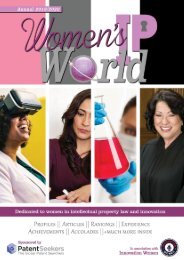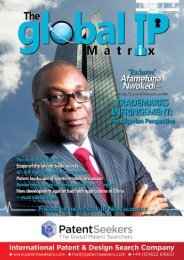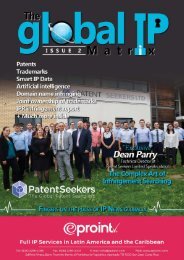Global IP Matrix - Issue 5
It has been a fantastic year for The Global IP Matrix magazine, thanks to all the efforts made by our contributors and to you, the reader for your continued support. We take great pleasure in putting together each issue of this publication, and we sincerely hope you enjoy this final issue of 2019. We have again, collaborated with some of the world's most influential IP law firms and businesses to bring you another eclectic mix of content, direct from the professionals working at ground level. We are already excited for the coming year and cannot wait to continue growing and evolving in our partnerships to bring you some exciting new features for 2020. Ms. Elvin Hassan Editor & Head of international liaisons
It has been a fantastic year for The Global IP Matrix magazine, thanks to all the efforts made by our contributors and to you, the reader for your continued support. We take great pleasure in putting together each issue of this publication, and we sincerely hope you enjoy this final issue of 2019. We have again, collaborated with some of the world's most influential IP law firms and businesses to bring you another eclectic mix of content, direct from the professionals working at ground level. We are already excited for the coming year and cannot wait to continue growing and evolving in our partnerships to bring you some exciting new features for 2020.
Ms. Elvin Hassan
Editor & Head of international liaisons
You also want an ePaper? Increase the reach of your titles
YUMPU automatically turns print PDFs into web optimized ePapers that Google loves.
The road ahead for<br />
autonomous vehicles:<br />
a patent report<br />
Patent landscape reports give a<br />
snapshot of the patents in a specific<br />
subject area or which cover a type<br />
of technology. Generally taking<br />
one to two weeks to complete, a<br />
landscape report can cover hundreds<br />
or thousands of patent families. The<br />
reports can be used to visualise and<br />
discover existing gaps in relevant<br />
areas, gain competitive intelligence by<br />
understanding the current landscape,<br />
predict where your market is heading<br />
and spot trends in areas of interest<br />
to aid investment. They are a critical<br />
step in research and development as<br />
well as competitive or patent strategy<br />
for any company or institution.<br />
You can execute your landscape search more<br />
efficiently and accurately with PatBase, a highquality,<br />
comprehensive patent search and analysis<br />
platform that uses enhanced data and enables<br />
searchers to conduct complex searches across the<br />
widest full-text collection available.<br />
By Caitlin Kavanagh, Marketing Executive, Minesoft<br />
www.minesoft.com<br />
This generates a broad discussion of the advantages and disadvantages of these type of cars. On the one<br />
hand, all human factors and climate influences can be switched off. However, the human brain identifies and<br />
predicts things that cannot easily be automated, like pedestrians and other obstacles crossing the road. Also,<br />
cars need to be able to drive in both crowded areas like cities and on highways with rather straight forward<br />
traffic; driving a car involves more than just handling the technical equipment in the car, for example, road<br />
safety, navigation, traffic lights, road signs, etc.<br />
Is this a growing area of interest<br />
In the following sections, PatBase Analytics V2 is<br />
used to extract insights and answer the questions<br />
below for the fast-growing technology area of<br />
autonomous vehicles.<br />
• Is this a growing area of interest?<br />
• What are the fields of current interest?<br />
• Who are the key players?<br />
• Where are the key players filing their inventions?<br />
• Who are the most influential leaders in this area?<br />
Driverless cars:<br />
an introduction<br />
Autonomous driving involves the act of propelling<br />
and navigating a vehicle without human input when<br />
travelling from point A to point B. The Department<br />
of Motor Vehicles (DMV) in California has setup<br />
strict regulations for testing driverless cars.<br />
The autonomous vehicles testing regulations were<br />
adopted on 19 May 2014 and became effective from<br />
16 September 2014. Permission has been given to<br />
many car producers like Volkswagen, Mercedes<br />
Benz, Google, Tesla Motors, Bosch, Nissan, GM,<br />
BMW, Honda, Ford, and some others to test<br />
driverless cars.<br />
However, the first fatal accident involving an<br />
autonomous vehicle took place in Williston, Florida<br />
on 7 May 2016 where a Tesla Model S electric car<br />
was engaged in autopilot mode. Shortly after, a<br />
second accident occurred wherein a Google car was<br />
involved.<br />
Most recent 20 years by families, applications & grants<br />
Studying the most recent 20 years by families, applications & grants shows that the driverless cars technology<br />
area is a fast-growing one. The dip in applications can be explained by the 18-month lag between when<br />
patents are applied for and when they are published. In fact, the number of applications has increased almost<br />
exponentially between 2009 and 2017.<br />
This technology area<br />
is continuing to grow<br />
globally, with China<br />
surpassing the US<br />
in 2016. Filings in<br />
Germany, Japan, and the<br />
European Patent Office<br />
have remained pretty<br />
consistent over the past<br />
20 years with a recent<br />
peak in 2016 – 2018<br />
worldwide, as reflected<br />
in this graph.<br />
Most recent 10 years<br />
by CPC group and<br />
number of families<br />
What are the fields of current interest?<br />
14 www.gipmatrix.com












